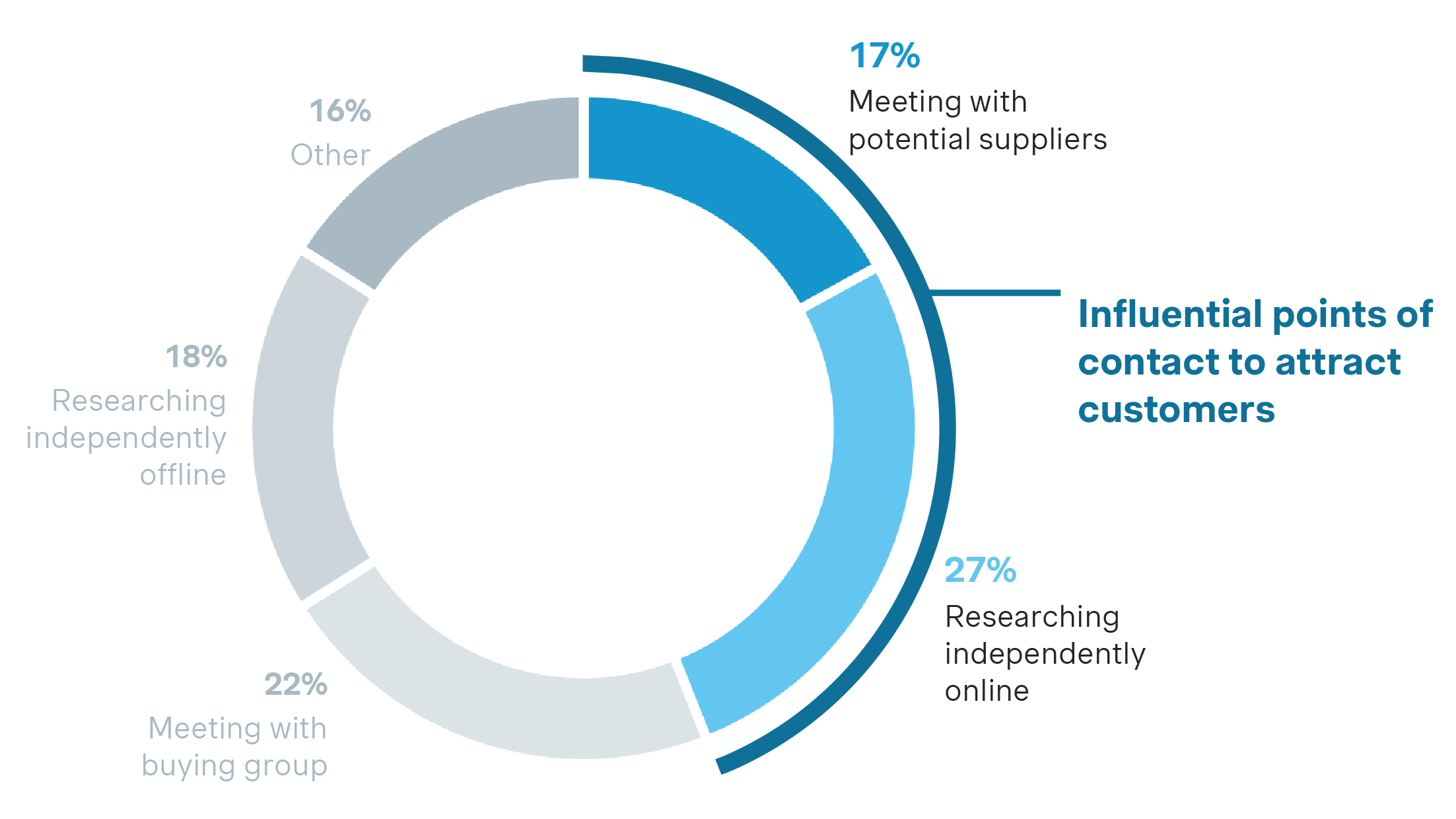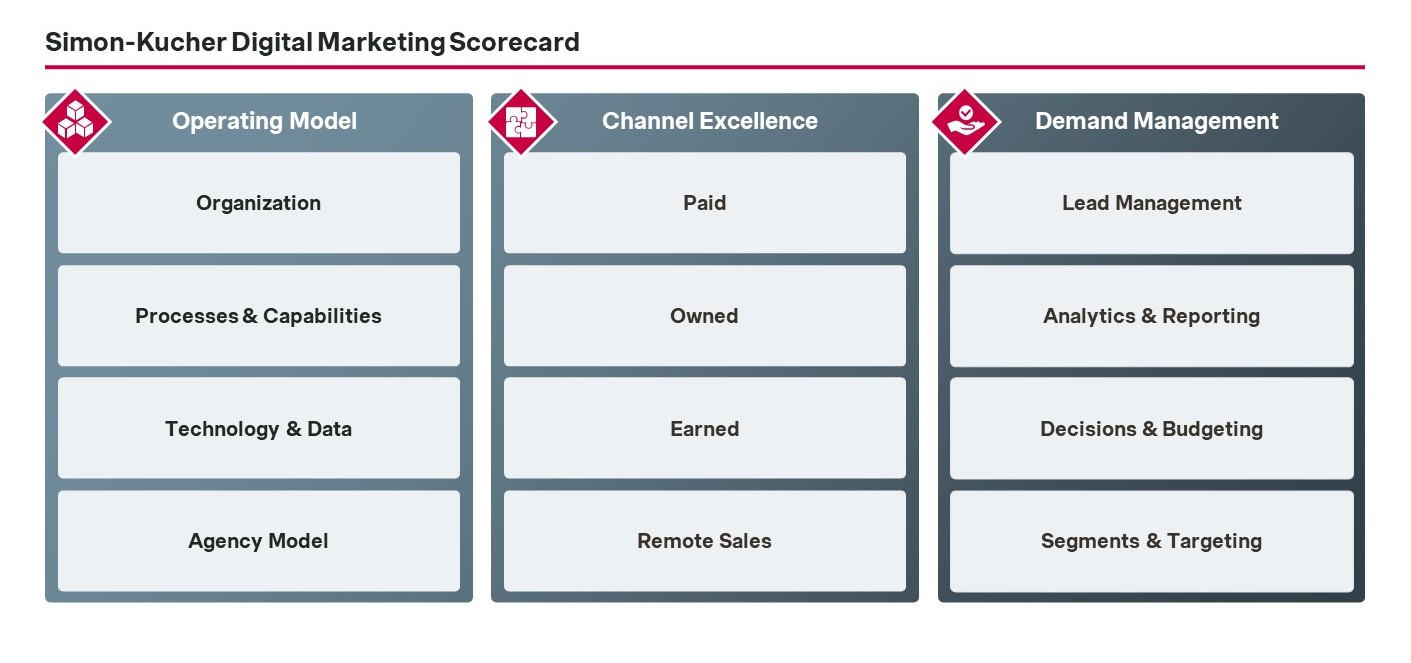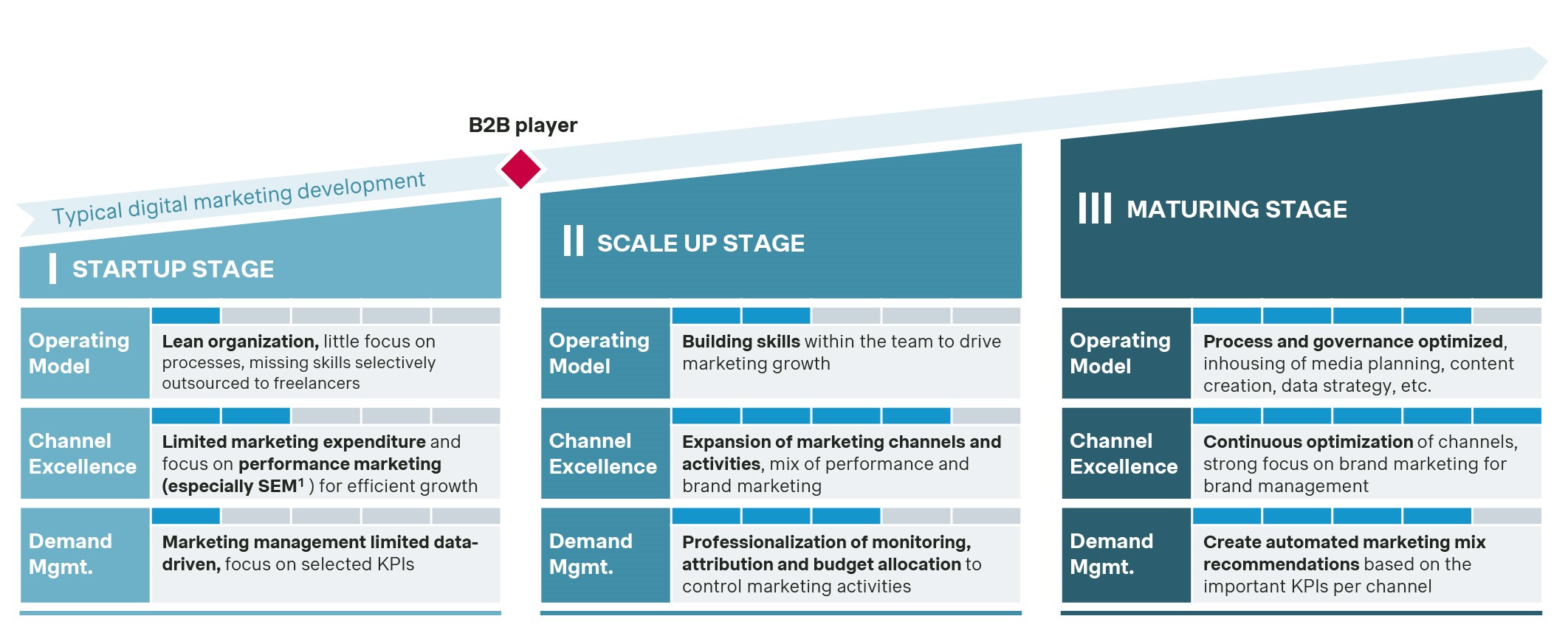Digital marketing and sales channels are transforming traditional B2B sales methods. An increase in online offerings, younger B2B buyers, and the aftereffects of COVID-19 have boosted the popularity of digital marketing methods. This shift is reshaping how businesses connect, engage, and drive sales in evolving B2B markets.
Research predicts that 80 percent of B2B sales interactions between suppliers and buyers will occur in digital channels in 2025. 43 percent of B2B buyers prefer a sales-rep free purchase experience. When only considering millennial B2B buyers, the figure even rises to 54 percent.
Moreover, B2B buyers spend on average only 17 percent of their total buying time interacting directly with supplier sales teams. With an average of three suppliers considered, this leaves only around 6-7 percent for each competitor. A much larger part (27 percent) of their buying activity consists of independent online research.
As B2B companies compete for awareness and sales in the market, digital channels are becoming increasingly vital for their growth.

How B2B buying groups allocate their time across key buying activities (Source: Gartner Digital B2B Buyer Survey n=750)
To create demand and drive growth in B2B, it is therefore crucial to be present where the customers are: online. Digital marketing in B2B companies is becoming a crucial to engage with new and existing customers and foster future growth. To stay competitive, B2B companies, especially those without established digital marketing capabilities, must catch up.
Digital marketing excellence — Assess your status quo
When executing effective digital marketing in B2B, it is important to consider all its dimensions and the respective maturity level of your company. The Simon-Kucher Digital Marketing Scorecard provides guidance on these various dimensions to assess the overall digital marketing maturity of B2B organizations.

Operating Model
This subdimension examines how a company structures its digital marketing team. It looks at the clarity of roles and responsibilities, the integration of digital marketing within the broader organizational framework, and the presence of a culture that supports agile, data-driven decision-making. A mature organization will have cross-functional collaboration and a dedicated team that is well-aligned with the company’s overall business strategy
Processes and capabilities focus on the efficiency and effectiveness of digital marketing operations. This includes the presence of standardized processes for campaign management, the use of marketing automation tools, and the ability to leverage data analytics for continuous improvement. Companies with mature capabilities will have dedicated specialists for both paid and owned channels, ensuring a holistic and strategic approach to digital marketing efforts.
This subdimension evaluates the technological infrastructure supporting digital marketing activities. It covers the adoption of advanced marketing technologies such as CRM systems, data management platforms, and marketing automation tools. A company with high maturity will have integrated technology solutions that enable seamless data flow and provide actionable insights to enhance marketing performance.
The agency model consists of how a company leverages external resources (e.g. marketing agencies or freelancers) for its digital marketing efforts. This includes evaluating the effectiveness of partnerships, the clarity of roles and responsibilities between the company and the agency, and the processes for selecting and managing agency relationships. A mature agency model will ensure that agencies complement internal capabilities and contribute to strategic goals.
Channel Excellence
Paid channel excellence contains of a company’s capabilities in managing paid digital marketing channels, such as search engine advertising, display ads, and social media advertising. It includes the ability to design, execute, and optimize paid campaigns to achieve specific marketing objectives. Mature companies will have specialists who can strategically manage and maximize ROI from paid media investments.
Owned channel excellence focuses on the management and optimization of owned digital channels, including the company website, blogs, and email marketing. This subdimension evaluates the effectiveness of content strategy, user experience design, and the ability to drive engagement and conversions through these channels. Companies with high maturity will have dedicated teams ensuring consistent and high-quality content across all owned platforms.
Earned channel excellence assesses a company’s effectiveness in generating and managing organic visibility and engagement through channels like social media, public relations, and influencer partnerships. This includes the ability to foster positive brand reputation and leverage word-of-mouth marketing. Mature companies will actively manage their earned media efforts to enhance credibility and reach.
This subdimension examines how B2B companies utilize inside sales teams to qualify and convert leads generated through digital marketing efforts. It focuses on the systematic process of nurturing and engaging leads, either converting them directly through remote sales or handing over highly promising leads to field sales teams. Mature companies will have dedicated remote sales representatives who are skilled in leveraging digital tools and data insights to effectively manage and convert leads, ensuring a seamless transition from marketing to sales and maximizing the potential of every lead.
Demand Management
Lead generation management evaluates the processes and tools a company uses to attract, nurture, and convert leads into customers. This includes the use of lead scoring, nurturing campaigns, and CRM systems to manage the lead pipeline. Mature companies will have integrated lead management systems that ensure efficient and effective conversion of prospects into sales.
This subdimension looks at how a company tracks and measures the success of its digital marketing efforts. It involves the use of KPIs, regular reporting, and the ability to analyze and act on performance data. Mature companies will have robust measurement frameworks in place that provide clear insights into the ROI of digital marketing activities and guide strategic decision-making.
Decision-making and budgeting assess a company’s ability to make informed strategic decisions and allocate resources effectively. This includes the processes for setting marketing budgets, evaluating ROI, and adjusting based on performance data. Mature companies will have transparent and data-driven decision-making processes that optimize the allocation of marketing resources to achieve strategic goals.
This subdimension examines how well a company identifies and targets specific customer segments. It includes the use of data-driven insights to understand customer behavior, preferences, and needs, and the ability to tailor marketing efforts to different segments. Companies with mature capabilities in this area will have sophisticated segmentation strategies that drive personalized and effective marketing campaigns.
Our scorecard helps to benchmark B2B players along these three mutually exclusive and collectively exhaustive dimensions:
Operating Model
Your organization must establish systems for cross-functional collaboration and efficient workflows to effectively implement a digital marketing strategy. The marketing team and other departments also require the right tools and data to enhance their productivity.
Based on the level of maturity and internal resources, leveraging external marketing agencies or freelancers can potentially help to drive digital marketing activities. To ensure that investments in external partners have the desired impact, it is essential to establish a well-defined agency model and in-house capabilities. This setup can help independently track the success of agencies and marketing measures.
Channel Excellence
Your B2B company must utilize the available digital marketing channels effectively to engage customers and create awareness for your products and services.
When used systematically with a focus on ROI implications, paid marketing channels and owned channels like the company website are indispensable for driving online awareness and winning customers. Earned channels, such as independent product reviews or appearances in industry magazines, build trust and credibility.
Active remote sales functions can enhance lead qualification and nurturing, boosting the effectiveness of your channel strategy.
Demand Management
The attention generated through digital marketing in B2B only translates into tangible sales if leads, conversions, and marketing budgets are managed diligently. You must effectively manage leads to ensure prospects convert to customers. With analytics and reporting systems in place, marketing teams are able to track if their campaigns can yield the expected profit impacts and ROIs.
One of the biggest challenges in demand management is to attribute successful sales conversions to the marketing channel from which the lead was generated (lead attribution). Research shows the average customer has 6-8 touchpoints before placing an order. A customer may interact with a social media campaign, visit the website through a Google search, and later type the URL directly into their browser. This makes it challenging to determine the precise number of leads and conversions generated by each marketing channel.
Implementing a systematic lead attribution logic helps rate marketing channel’s efficiency and base marketing decisions and budget allocation on fact-based insights instead of a gut feeling. To optimize marketing budgets, it is beneficial to incorporate customer segmentations and target customers based on their demographics or previous behavior.
Here’s how you can elevate your B2B digital marketing efforts
Upon evaluating the level of maturity of digital marketing in your B2B organization across our Digital Marketing Scorecard’s three dimensions, you must develop an action plan to progress to the next level.
To effectively progress in digital marketing, it is crucial to consider a company's individual circumstances and level of maturity. Most companies don’t need to immediately build a large in-house team of dedicated marketing experts or invest very large sums of marketing budget in paid ads right away.
Our project experience shows: each situation requires an individual approach — to use budgets efficiently, to not overwhelm the organization, and to achieve quick wins.

Stages of digital marketing maturity in B2B (Source: Simon-Kucher; 1: SEM = Search Engine Marketing)
Case Study: German B2B SaaS company
Within five weeks, we transformed a B2B SaaS startup's digital marketing from a beginner level to a professional setup, resulting in immediate impact. (e.g. tripling organic reach within a week of implementation).
Our comprehensive action plan aimed to enhance the effectiveness of their marketing team. This strategy involved establishing crucial marketing processes and tools, including developing a cross-channel SEO approach. Our approach integrated traditional SEO with modern information discovery tools, e.g., social media, being increasingly used for independent online research.
We also implemented a leading CRM system and automated workflows, enabling the marketing team to operate more efficiently. This initiative helped enhance the team’s capabilities and provided clear, actionable insights through relevant KPIs.
Here’s a highlight of how we drove our B2B client’s digital marketing strategy to the next level:
Pillar 1: Operating Model
- Processes and Capabilities
We began by bridging the skills gap within the client's marketing team. For this, we created a comprehensive social media strategy, including a detailed posting and branded content plan. Also, we conducted onboarding sessions to familiarize the team with the newly implemented Martech tools and strategies, ensuring seamless integration and immediate usability.
As the next step, we analyzed, refined, and implemented automated workflows, including email marketing automation through HubSpot. We employed automation to enhance the operational efficiency of the marketing team. In developing the automated workflows, we focused on covering all phases of the marketing flywheel to ensure the effectiveness of the initiatives.
- Technology and Data
We facilitated the team's shift from Brevo to HubSpot, implementing streamlined CRM processes, workflows, and KPI tracking.
Our tailored dashboard implementation enabled the client to monitor critical KPIs and for future data-driven decision-making. We also keenly focused on selecting key metrics to provide the client with a clear and actionable overview of their performance.
- Agency Model
By curating a shortlist of qualified agencies for the client’s website relaunch, we ensured alignment with project objectives and verified relevant expertise. While spearheading the website relaunch, we also offered strategic direction to the agency to enhance the user experience and ensure compliance with tight project timelines.
Pillar 2: Channel Excellence
- Owned Channel
Our team created a new state-of-the-art website mockup to guide the redesign, enhance performance metrics, and improve user experience. We collaborated with and steered an agency to redesign the client's website. Additionally, we developed and implemented a cross-channel social media posting plan.
- Earned Channel
We created a structured approach to amplify the client’s customer success stories on social media, including developing a questionnaire for client interviews. This initiative aimed to leverage social media platforms like Instagram, where visual content is increasingly influential in consumer decision-making.
Pillar 3: Demand Management
- Lead Management
By analyzing the client's customer journey, we created a lead-funnel framework that identifies important KPIs like channel-specific conversion rates and cost of acquisition measures. This helped us enhance their systematic lead generation and evaluation.
- Decisions and Budgeting
In addition, we established transparent KPIs and reporting systems, which form the basis for data-driven decision-making processes. This alignment helped synchronize marketing budgets with their growth objectives and channel-specific performance metrics.
Impact achieved
In just five weeks, we successfully executed a strategic plan to develop and launch a new website, meeting a tight deadline through strong collaboration and efficient agency management.
Our team created a complete social media branding kit, leading to a remarkable 200 percent increase in organic reach within the first week of implementing it. We also provided the client with more than 20 pre-designed branded posts to facilitate ongoing independent social media activity.
Our efforts to equip the client with tangible assets such as a posting plan and templates, along with onboarding for newly implemented automation tools, enhanced their ability to manage marketing activities and leverage data insights for continuous improvement.
Kickstart your B2B digital marketing journey with Simon-Kucher
The digital consulting experts at Simon-Kucher Elevate have a dedicated focus on commercial growth. Our team aims to optimize your entire customer journey by combining technology, data, and creativity with commercial consulting expertise.
We will not only analyze the impact of digital marketing trends on your B2B organization's success but also provide you with impactful strategies to propel your growth.
Contact our experts today to discuss the best way forward for your B2B digital marketing needs.


